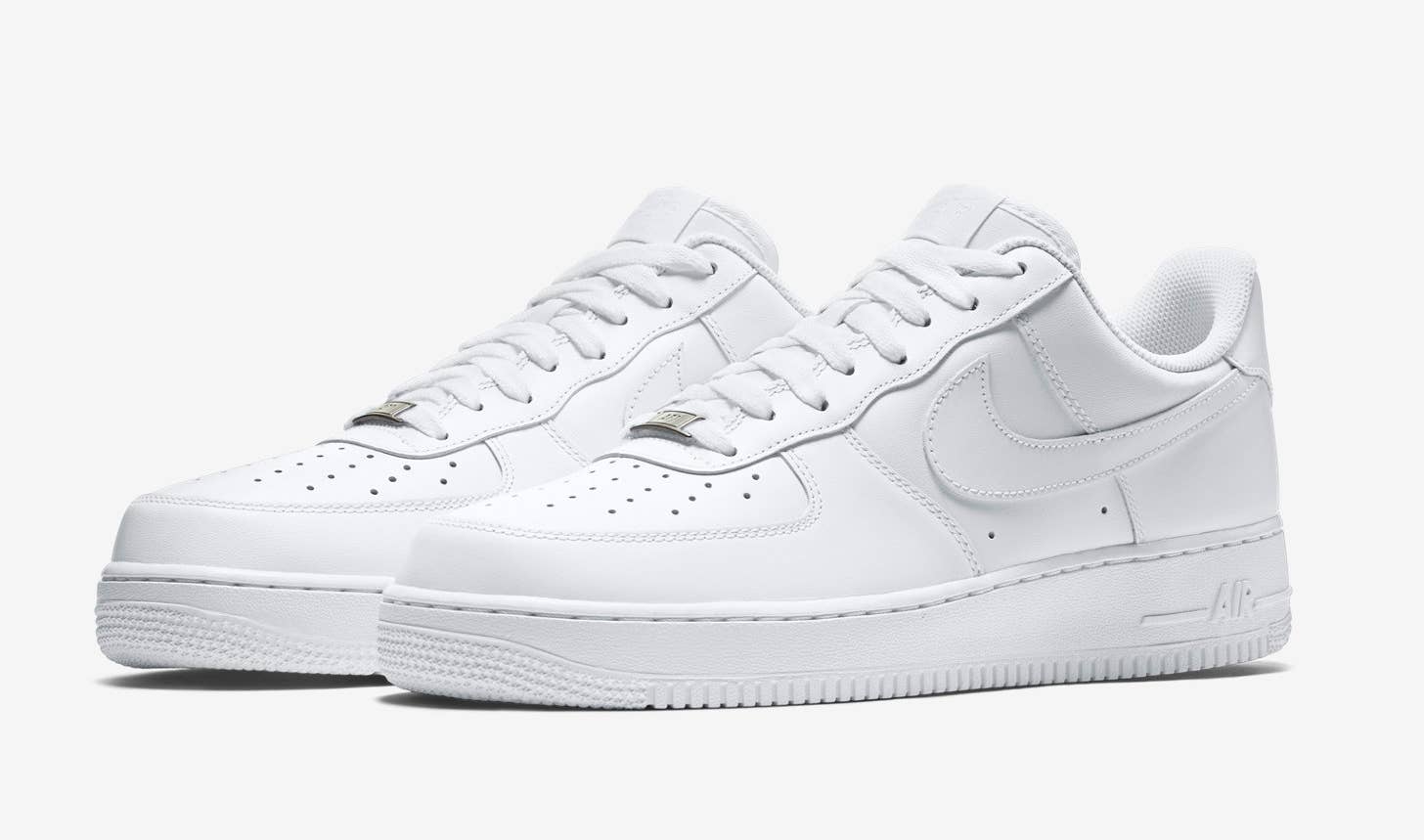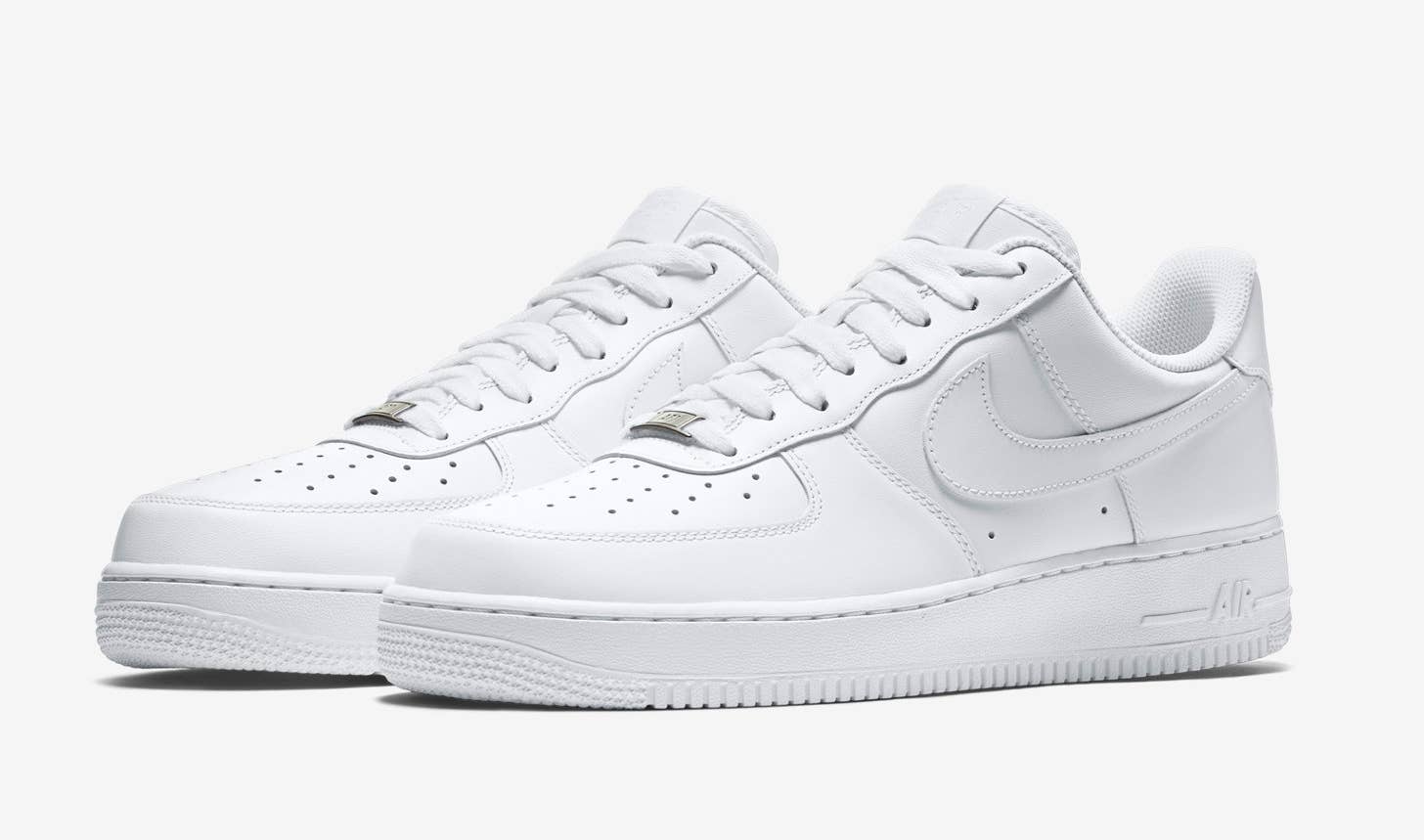
In the world of sneakers, few styles last. The ones that do are the true classics—the trends that graduate to staples. They’re consistently worn by both footwear enthusiasts and the general public. For Nike, the shoes that sell shareholder-pleasing units tend to be white leather shoes like the dad-friendly Air Monarch line—ones that cool kids and connoisseurs hate. One rare example of such sneakers that cross over into both worlds is the Nike Air Force 1 in its most popular, iconic style: low-cut, in all-white.
The white Air Force 1 Low is one of the bestselling shoes of all time. A decade ago, sporting-goods analyst Matt Powell told the New York Times that the shoe sold an estimated 12 million pairs in 2005 alone, more than two decades after its debut; the sneaker is still Nike’s second bestseller a decade later, according to Powell. The hyped-up collaborations and limited-run collectibles may have given the AF1 a covetable level of prestige and helped spread its gospel to new generations, but the monotone makeups, particularly the white-on-white, have been the ones keeping the lights on at most sneaker shops over the years.
On its 1982 introduction to the court, Nike designer Bruce Kilgore’s creation, initially only available as a high top, was striking for its hiking-boot-inspired cues and uniquely chunky sole—it was the first Nike Air cushioning on a hoops shoe. The neutral white and grey palette was one of the only parts of the shoe that played it safe. Inevitably, bolder, team-color Forces would follow—as would a low-cut, making the Air Force 1 an even more popular choice when it hit retail on a wider scale in 1983.
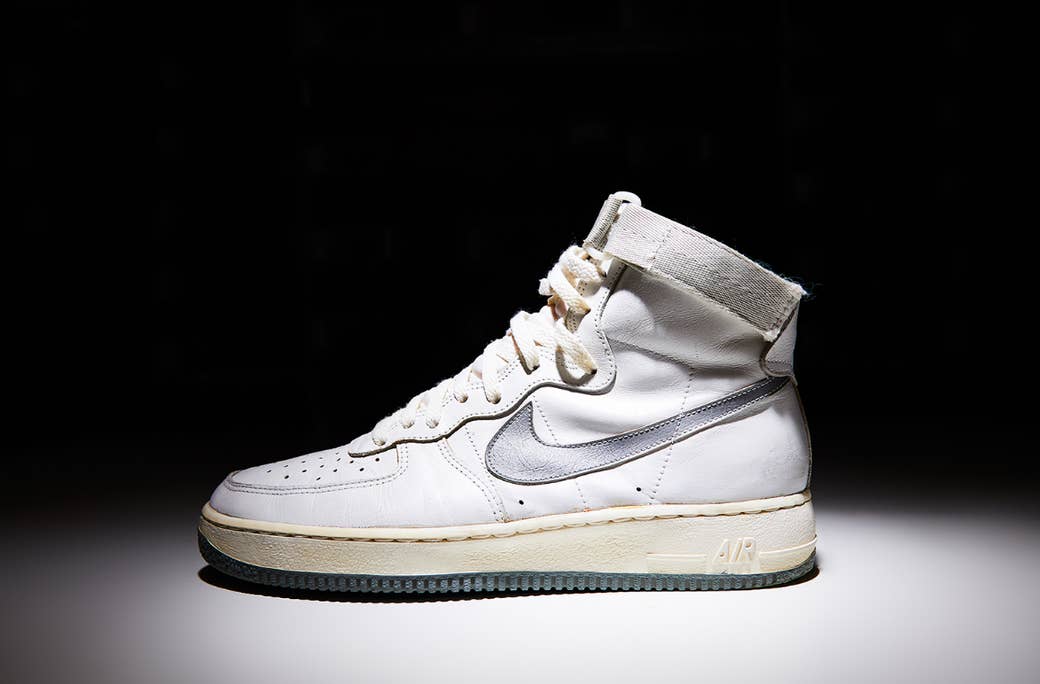
Nike’s initial intent was to shelve the AF1 in favor of the next style, the next technology. But the model lengthened its lifeline thanks to an extended collection of different colors, a byproduct of a “color of the month” initiative pushed by a cartel of Baltimore retailers (Charley Rudo, Downtown Locker Room, and Cinderella Shoes) making ambitious orders for special makeups. Those exclusives turned the city into a destination for Forces; footwear tourism along Interstate 95 brought the sneaker’s cult status to D.C. and New York. Phased out shortly afterwards, the AF1 returned around 1986 to select East Coast stores (with a slightly altered shape complete with more regional exclusives). Rarely spotted makeups could be acquired by those in the know from fabled stores like Troop co-founder Teddy Held’s long-defunct spot in the South Bronx, nicknamed “Jew Man.”
Big brands don’t acknowledge it openly, drug dealers and hustlers were the true style influencers of their era. As a result of the crack epidemic that tore apart East Coast inner cities from roughly 1984 to 1993, there was plenty of expendable dough to be spent. Dealers’ pristine shoes, ostentatious automobiles, and oversized jewelry set a new standard of aspiration — one that required the kind of money that only the fast life seemed to provide. Footwear prices may have recruited a fair share of soldiers, and those soldiers in turn helped birth even more sneaker fanaticism.
The sneaker has a history of very little marketing, outside of the original ads that featured the likes of NBA stars Moses Malone and Mychal Thompson, but it was sold by Nike strictly in inner city markets. According to journalist Bill Brubaker and an unnamed source in a March 1991 Washington Post article, “The company... sends a ‘special makeup’ model — the Air Force One, which was introduced in 1983 and sells for about $80 — to selected inner city stores. ‘This shoe is strictly inner city,’ one Washington retailer said. ‘It’s not in Nike’s catalogue, but it sells well among blacks.’”
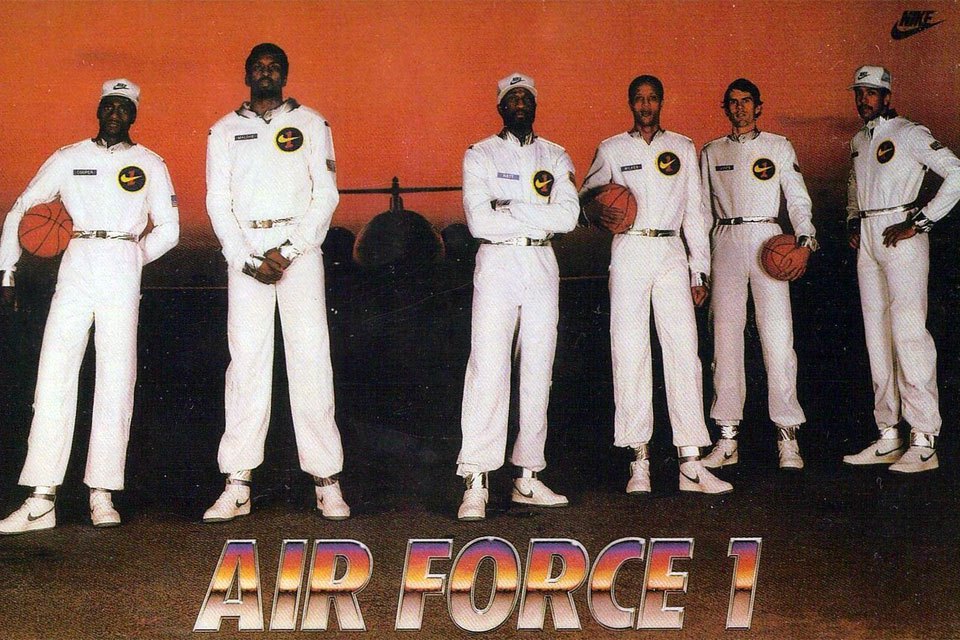
The subsequent gentrification of urban sneaker culture gives the impression that the AF1 is a people's shoe that transcends race, gender, and class. But without its initial inner city fan base keeping it alive, the Force would most likely be little more than a shoe praised by true connoisseurs and historians but forgotten by everyone else.
Then came the all-white Low. Crispy like white Reeboks — a popular hustler shoe in certain NYC boroughs, back when such stylistic divisions were a thing — the white on white colorway let the ageless look of Kilgore’s creation speak. But when exactly the white Air Force 1 Low was first released remains something of an enigma. The time between the AF1's 1986 reissue and the early 1990s reworking of the shoe’s design to eliminate its mesh side panels is so shoddily documented. It’s patchy to the point where it's understandable if some think that the shoe never even came into being until the late 1990s. All we've got scraps to go on are showoff Polaroids, album sleeves, and old ads.
Insider sources claim that the all-white all-leather Low debuted in 1997, but seeing artists like the Bronx's own Lord Finesse in white-on-white highs circa 1992 (and by that point, select regional Foot Lockers had the white highs as a limited release) casts doubt on that. Just to reiterate that Baltimore's love for the shoe was long-term, a 1994 ad for the city's still-standing Holabird Sports advertises all-white or -black highs or lows (priced at $62.95 or $57.95 respectively).
Then there were the subtle variants to keep things confusing. Off-white lows with the brown outsole were available in select spots in 1991, while an array of white canvases with gum soles were on sale in the mid-1990s. A gleaming all-white patent low was released as part of a pack in 1996.
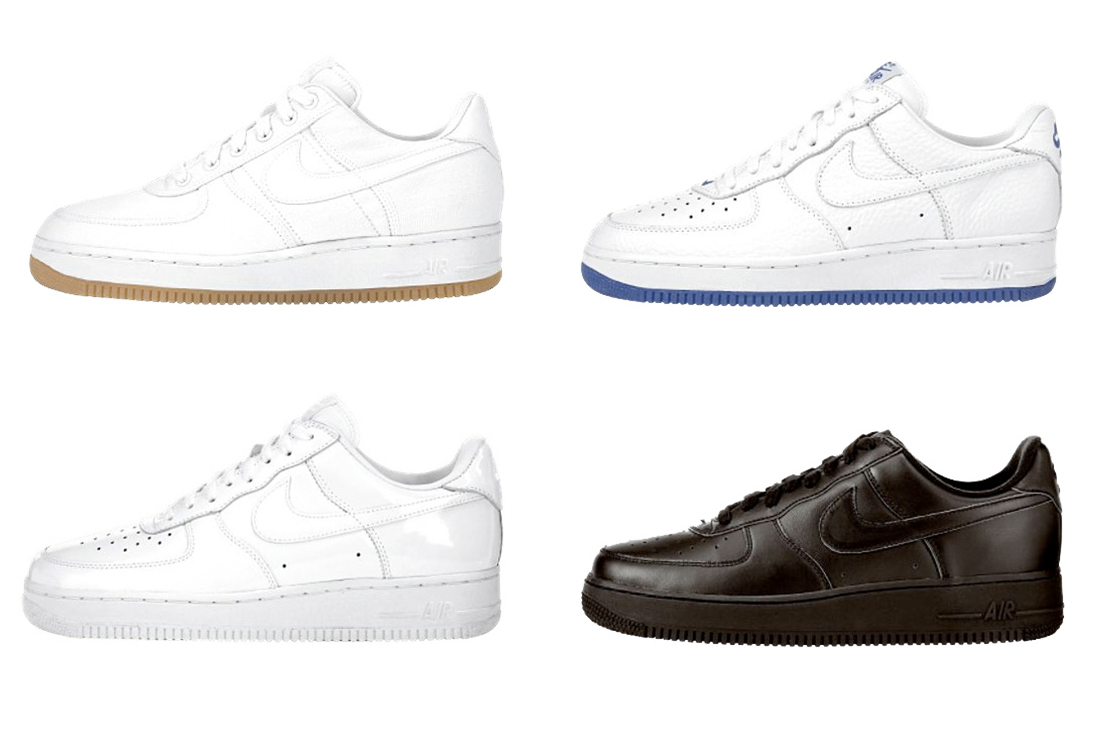
Whenever they were officially debuted, all-leather, white-on-white lows quickly became a strong seller thanks to an existing inner-city fanbase; Nike knew how to build hype among the already loyal fans. At one point, Nike’s Limited Edition team – with quickstrike and retro pioneers like Nike employee Drew Greer in the mix —temporarily denied supply of the white-on-white lows for a moment to build demand and exclusivity. As the 1990s progressed, the distribution of the AF1 expanded beyond its key cities. The 1994 introduction of the often-maligned Air Force 1 Mid and a carefully orchestrated “City Attack” project that spawned the familiar Nike NYC logo was the tactical precursor to a global rollout that would send the white on white overseas.
In terms of pop culture, the white Air Force 1 low made a significant impact. Sneakers had been name dropped since hip-hop’s infancy, but how many had been called out in a specific colorway? Forces had been mentioned in general terms before. 3rd Bass’s Pete Nice rapped, “Bought the Nike Air low cuts off the Jew man,” on his 1993 song “Outta My Way Baby”).
But Brooklynite and former hustler Jay Z was one of the first to specifically shout out white Air Forces Ones, helping cement them as an East Coast hood classic. On the song “Can I Live II” — reportedly recorded during Reasonable Doubt sessions but only added to the LP for a 1998 reissue — a young Jay rapped, “For all my niggas with the all-white Air Force Ones and black guns.” Subsequent raps from Shyne, The Lox, and G-Unit further singled out white on whites. Fellow Roc-A-Fella mastermind Dame Dash would talk up the wear-once-and-give-away mentality (reportedly encouraged by conversations with original AF1 connoisseur and white-on-white fanatic DJ Clark Kent) during TV interviews in the early 2000s. And when the Diplomats blew up, they took pristine white lows at this point already nicknamed Uptowns because of their ubiquity in the crew’s neighborhood—with them as part of the Harlem renaissance.

Distributed well enough to sprawl far beyond the East, the Air Force 1 hit the Midwest hard enough that St. Louis-based artist Nelly was stockpiling colors. At the peak of his popularity, Nelly dropped “Air Force Ones,” an anthem about the shoe complete with a video festooned with a questionable selection of color/material variations. It was a hit, and operated as a constantly played commercial that normalized buying multiple “purrrrs” with lines like “Now don't nothing get the hype on first sight like white on whites.”
Nike was quick to reward rap’s unofficial endorsees by going off the grid and working with the likes of plugged-in NYC shoe retail legend Udi Avshalom, who ran the now-defunct sneaker store chain Training Camp, to create branded white on whites with simple stitched Roc-A-Fella logos. That was followed by white-on-white Nellyville versions and tributes to Fat Joe’s Terror Squad.
In London, the burgeoning grime scene popularized the all-white and all-black Force that was readily available at High Street stalwarts JD Sports (who also peddled their own sought-after line of UK-exclusive SMUs). In year 2005, three years after Nelly’s hit, Atlanta’s trap pioneer Young Jeezy got his own signature Air Force 1s, too. The sneaker silhouette that entered street culture as an attention-grabbing anomaly had become a mandatory street staple, paired with a white tee and big jeans for a uniform of dope boy anonymity. With more availability and a lower price point than it had over two decades prior, the Air Force 1 was a phenomenon. The sneaker was as easy to replace as it was to crease — but instead of alienating wearers, its quality control issues were practically celebrated.
The simplicity and perceived perfection of the AF1 in its neutral state was such that even the tiniest alteration — highlights on the heel, a different logo, or an icy sole — was striking enough to earn a nickname of its own and a level of bragging rights for anyone that snagged a pair.
For those looking to cover their shoes in flashy embellishments, the model would become the victim of many a botched custom in the early 2000s. Given the simplicity of the design by modern standards, AF1 rip-offs became an inevitable epidemic. Nigo’s Bapestas were accused to having an almost identical silhouette, but at least it brought something extra to the table in terms of material (shiny patent leather) and crazy colors (in turn inspiring Nike to get more outrageous in their executions). The white on white Low was also imitated by Lugz for their Birdman shoe and, bizarrely, by Reebok for their popular I3 Pressure shoe, which seemed like a bid to stop Allen Iverson from wearing his beloved Forces. When Foot Locker and Nike fell out over pricing just as Nelly’s hit was still embedded in a nation’s psyche, the closest consumers would get to the Force Low on the chain’s shelves was the I3 Pressure. Sanity ultimately prevailed when both sides made up. But as the collector phenomenon boomed, things got silly elsewhere instead.
One true testament to the white Air Force 1’s reach was its constant place on the feet of lead character Jax in FX’s popular biker gang drama Sons of Anarchy. Realism was never the show’s strong point, but plenty of online criticism was leveled at those white shoes being affiliated with bikers. In a 2013 interview with Nerdist, actor Charlie Hunnam revealed that the AF1s were deliberately worn as part of an exact replica of the outfit worn by an Oakland biker he’d ridden with as research for the part.
For the Air Force 1’s anniversary in 2007 (complete with a Nike-funded Rakim, Kanye, Nas, and KRS-One track as well as a collaboration between Juelz Santana and Just Blaze), white lows were something of a centerpiece. The Anaconda Lux built on an earlier Italian-made concept and took it further with exotic skins and a hefty $2,000 price point. At the more affordable end of the scale, re-engineered white on whites used a 10A full grain leather that, it was claimed, was whiter than ever before.

Gradually, the white AF1’s role in the collector world was superseded by the next thing. Some blame anniversary overkill; other point to the slimming down of pants, which gave the wearer the “golf club effect,” But the AF1 kept selling. The shoe that had been the father of so many styles, strategies, and spin-offs became a dad shoe in itself, given that it had existed long enough to become deeply familiar with multiple generations.
In the sneaker-dude echo chamber, popular opinion was that the white was out the picture, but the assumption that hip-hop culture had collectively slipped into Rick and Raf to shed its old skin entirely was short-sighted. Many 'hoods were still keeping it loose and pristine, with a new breed of drill artists from Chicago’s Southside like Chief Keef (“White Air Force 1s cause that's how I'm feeling y'all”) rocking them regularly (normally with obnoxious belt buckles and True Religions). Paterson, New Jersey’s Fetty Wap showcased the look too, as did London’s road-level rappers like Giggs and Nines. As his career took off, Harlem’s A$AP Rocky popularized the much derided white AF1 mid—a move that, it turned out,was an in-joke between Flacko and his friends. He wanted to prove his influence by turning a trash shoe into a trend.
There have been modifications to the Force D.N.A. in recent years to tap into the high-end, high-top-wearing zeitgeist. Catering to a modern mode of dress, the launch of a towering white Special Field Air Force 1 late last year was well received.
You can't kill off the real deal, though. Nike failed to retire Air Force lows in the early 1980s and the classic white on white variation isn’t going to exit stores globally any time soon. As the original shoe reaches its 35th anniversary and its white on white iteration celebrates over two decades of staple status, the AF1 is still a foundational piece of footwear’s past and future — no advertisements were needed then, and they aren't needed now.

